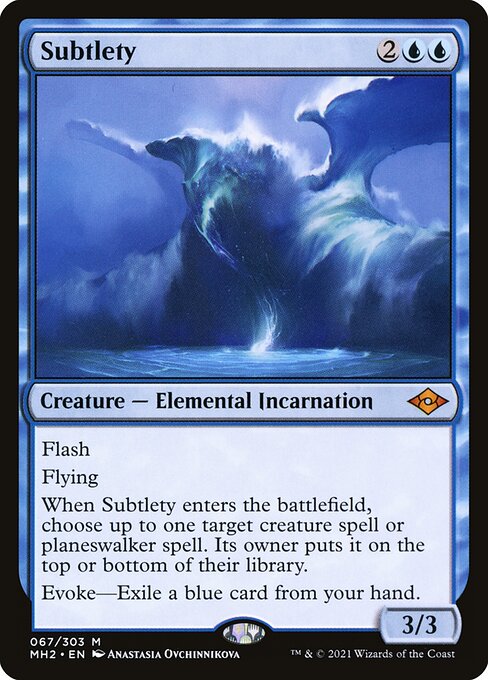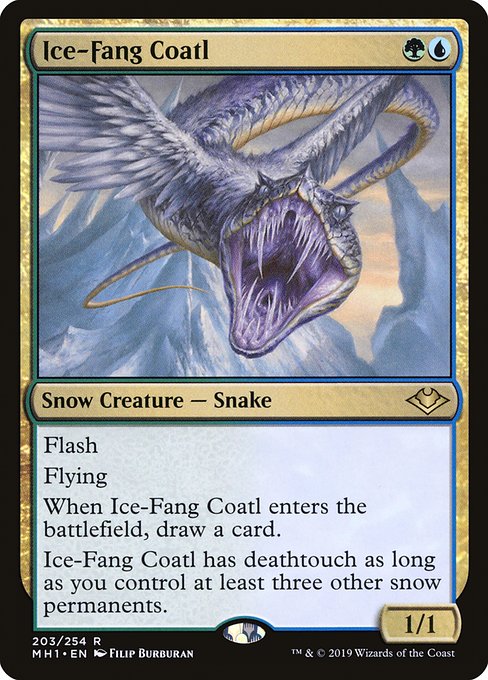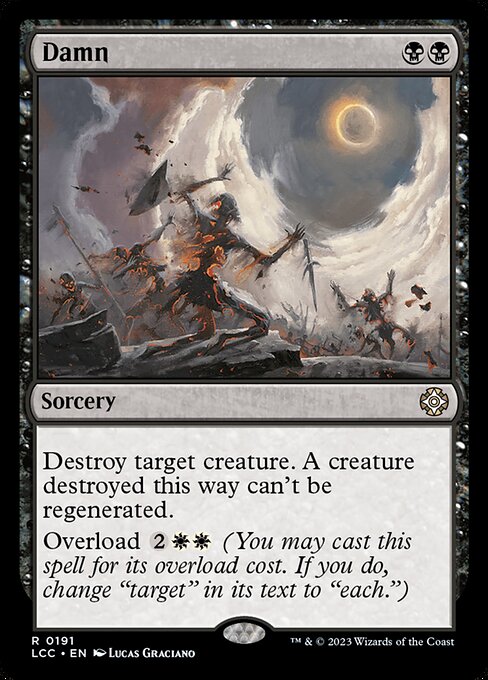It’s no secret how both of the Modern Horizons sets have drastically affected non-rotating formats like Modern, Legacy, and Pauper. What’s perhaps less clear is how much more well-received the sets are by Commander players compared to Modern players, and what this means for future straight-to-Modern sets. That’s exactly what I’m exploring today. Welcome back to the Commander Corner.

An Introduction to Modern Horizons
Personally, I spend too much time online. Because of this, I know that spoiler seasons tend to be hype-filled fiestas of cardboard grandeur almost all the time. However, the Modern Horizons sets have two major distinguishing factors that separate them from other supplemental sets.
First, Modern Horizons 1 & 2 are Modern legal. That might sound rather evident given their names, but this is a big departure from the precedent that most supplemental sets had set. Second, many cards that were previously not legal in Modern suddenly became legal through in-set reprints. These two facts offered the Modern Horizons sets an unprecedented level of hype for Modern players, who usually didn’t have a substantial metagame shakeup from comparatively underpowered Standard sets.
Oh, and Modern Horizons 3 is scheduled for next year.

The Spoiler Hype-Train to Post-Set Clarity Pipeline
It isn’t an understatement to say that the Modern Horizons sets massively tipped the scales of most eternal formats. Arcum’s Astrolabe, Hogaak, Arisen Necropolis, and Wrenn and Six were all banned in at least one format for their transgressions. Meanwhile, cards like Urza, Lord High Artificer avoided the ban hammer entirely. Keep a close eye on the basic template of Force of Negation, as “pitch” cards like this will come up again shortly.
If you want an insider’s perspective on some of those problem cards, one of the people involved with creating them gave us the scoop. It is expected that, in the process of trying something unprecedented and cool, that mistakes will be made. Unfortunately, however, many of those mistakes would be repeated or worsened for Modern Horizons 2.
Presently, the Modern metagame is absolutely skewed in favor of Modern Horizons cards, including several of the “pitch” cards like Fury, Endurance, and Grief, alongside the aforementioned Wrenn and Six which acts as a punishing gatekeeper to any small creatures in the format. Just as well, cards like Ragavan, Nimble Pilferer, Urza’s Saga, Archon of Cruelty, and many others occupy large parts of the Modern meta. Many consider these changes a net negative for the Modern format. But as interesting as that is, I’ve talked enough about just Modern for now.

Common (And Uncommon/Rare/Mythic) Denominators
Commander, as a multiplayer format with a much higher sum of life points between all players, has very different play patterns and goals compared to one-versus-one eternal formats like Modern and Legacy. However, some of the cards from the Modern Horizons sets are so universally powerful that they still have a presence in spite of these differences.
Esper Sentinel is a generally powerful card for white decks in Commander, whereas it mostly sees in play in Modern thanks to its card types overlapping. Urza, Lord High Artificer represents a lot of power and toughness alongside mana potential in other formats, while Urza tends to combo with cards like Winter Orb in Commander. Force of Vigor sees play as a generally efficient piece of removal in Commander rather than a silver-bullet sideboard option against artifact decks in other formats, and so on for a handful of other cards.

Secretly Commander Horizons?
Perhaps expectedly, Commander got a lot more out of Modern Horizons and Modern Horizons 2 than any other format. The enemy-color talisman cycle, including Talisman of Creativity, is wildly popular as two-mana rocks are always in demand. Just as well, multicolor mana-bases saw the printing of Prismatic Vista, a supremely powerful alternative to cards like Evolving Wilds, and enemy-color lands styled like Horizon Canopy as additional untapped multicolor mana sources. Artifact decks even got a boost from a cycle of tapped artifact lands like Drossforge Bridge.
It would be borderline impossible to list every card from both sets that’s made a splash in the format, as there are just a lot of them. When I say there are a lot of them, I mean it. Between both sets, there are easily more than 50 cards you could consider worthwhile playables at almost every level. This might seem obvious, given the higher power levels compared to Standard sets, but even supplemental sets rarely contain so many new goodies.

The Biggest Winners of Modern Horizons 1-2
If you love typal decks, Morophon, the Boundless is probably on your radar already. Just as well, many typal decks were treated to a whole host of neat inclusions like Changeling Outcast, Unsettled Mariner, and more.
If you are a fan of ninjas, Ingenious Infiltrator and Fallen Shinobi were wonderful additions. White decks were treated to Generous Gift alongside Hall of Heliod’s Generosity and Ranger-Captain of Eos. Green decks got Collector Ouphe, Springbloom Druid, and Yavimaya, Cradle of Growth.
More than a dozen powerful commanders were printed, from the aforementioned Ragavan and Urza to Asmoranomardicadaistinaculdacar, Grist, the Hunger Tide, and The First Sliver. If you’ve looked at the full list of cards, it might look like one or two particular colors might have been the biggest winners, but the true winner of the Modern Horizons experiment is the Commander format as a whole.

But… It’s Literally Called Modern Horizons
Yes, and that poses an interesting question. After all, if the goals of Modern Horizons 1-2 were to shake up the meta and experiment with wildly powerful new card designs, they succeeded in both of those regards. It’s simply a fact. The metagame before the release of Modern Horizons was drastically different. Just as well, both of these sets were released before most people considered Magic to be fully focused on Commander as its flagship format. So why, then, am I saying Commander was the biggest winner?
The short answer is that the design goals of WotC, the desires of Modern players, what makes a format healthy, and the desires of Commander players are very rarely all going to match up in a single set. Creating a format staple for Commander isn’t generally a problem, and creating a staple that’s a bit too strong still hits Commander less hard than it’ll ever hit Modern.
The long answer delves into the general philosophy behind both formats. It has general criticisms towards the design and development standards enforced by WotC and Hasbro, a long conversation about Rule 0, and a long conversation about the slow decline of competitive Magic. But, I’ll spare you another thousand words on that subject.

Implications For The Future
Ultimately, I think these sets were wonderful for Commander. Dozens of staples, lots of archetype-expanding spells, lots of archetype-supporting lands, some cards that induce salt at casual tables, and some which will only ever be at casual tables. Combining all of these together makes these sets slam-dunks for Commander, in spite of the issues they undoubtedly created in Modern. We’ll see next year how the next Modern Horizons set plays out.
I think a big lesson we can learn is WotC can often overshoot on power level when they design with a specific format in mind. We saw this with Commander Legends, and of course with both installments of Modern Horizons. I empathize with Modern players, although I haven’t the slightest clue how to go about fixing the format—if such a thing is even possible.
Whether you think WotC should fire from the hip and fix mistakes with bans, or that they should use a measured hand and play it safe, I’m certain the horizons hold plenty of other cards to play, to get mad about, and to draw Deflecting Swat on top of. I’ve been Luka “Robot” Sharaska, and this has been the Commander Corner.
Luka V. Sharaska (they/them) earned the nickname “Robot” by having a monotone voice, a talent for calculating odds, and a perfect poker face. Robot has been playing Magic for more than a decade, starting during the days of New Phyrexia in 2011.

